Recruitment is a crucial aspect of any organization and plays a significant role in the business’s success. Finding and hiring suitable candidates can be challenging and time-consuming, but having a qualified and motivated workforce is essential.
Our recruitment guide is designed to provide valuable insights and guidance for those involved in the recruitment process. Whether you are an HR manager, a hiring manager, or an individual looking to improve your recruitment skills, this recruitment guide is for you.
The following recruitment guide covers every step of the hiring process, from finding candidates to conducting interviews to extending employment offers. It offers helpful advice and best practices on how to find and choose the most qualified applicants, as well as how to prevent typical hiring errors.
Whether you are a seasoned professional or new to the field, this guide will be an indispensable resource for achieving your recruitment goals.
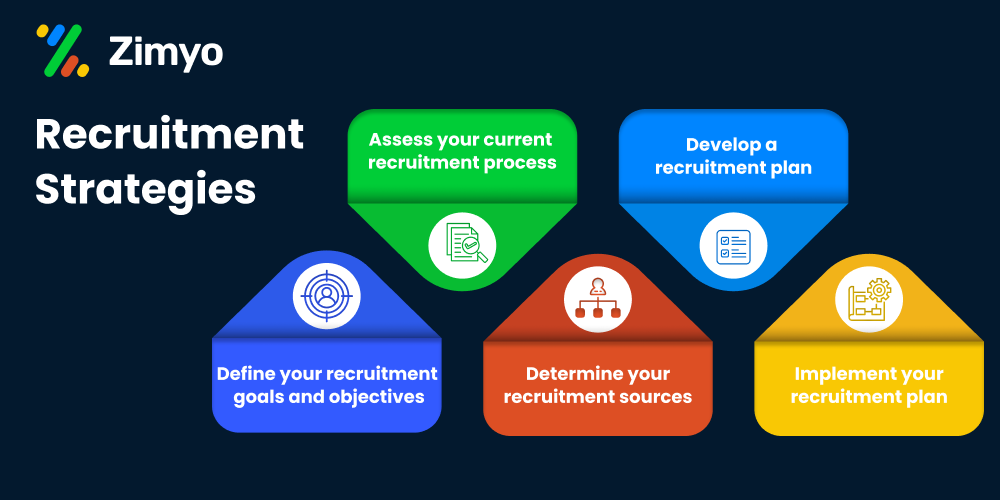
Recruitment is a complex process that requires careful planning and execution. Developing a comprehensive recruitment strategy and plan can help you attract and select the best candidates for your organization.
This part will explore the steps involved in creating a successful recruitment strategy and plan.
The preliminary step in the creation of a recruitment strategy and plan is to define your goals and objectives. What are you hoping to achieve through the recruitment process? Are you looking to fill a specific job vacancy, build a pool of candidates for future openings, or improve your overall recruitment process? Understanding your goals and objectives will help you determine the best recruitment strategies and tactics.
The next step is to assess your current recruitment process. What has been proven to work previously, and what areas need improvement? What are the glaring and minute strengths and weaknesses of your current recruitment strategies, and what are the challenges you face in attracting and selecting candidates? By analyzing your current recruitment process, you can identify opportunities for improvement and determine what changes are needed.
Once you have assessed your current recruitment process, you can begin to determine your recruitment sources. What are the best ways to reach potential candidates, and where do you find the best talent for your organization? Some common recruitment sources include job boards, social media, employee referrals, and recruitment agencies. Consider which sources will be most effective for your organization and your specific recruitment goals.
With your recruitment sources identified, it’s time to develop a comprehensive recruitment plan. Your plan should include the following elements:
With your recruitment plan in place, it’s time to implement it. Communicate your recruitment plan to all relevant stakeholders, including hiring managers and HR staff. It’s also important to regularly monitor and evaluate your recruitment strategies’ effectiveness and make necessary adjustments.
In conclusion, creating a comprehensive recruitment strategy and plan is essential for attracting and selecting the best candidates for your organization. Following the steps outlined in this chapter ensures that your recruitment process is efficient, effective, and results-driven.
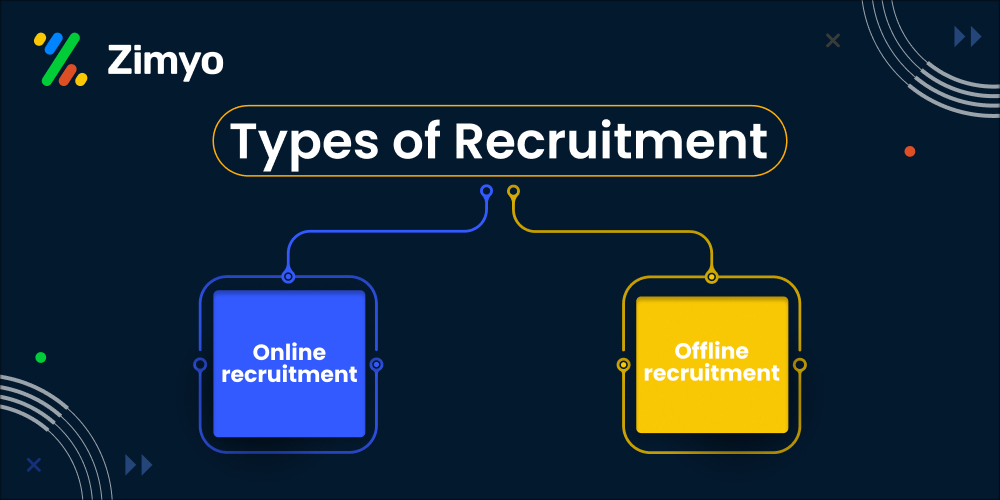
Online and offline recruitment are two standard methods used by organizations to recruit new employees. Both have their own advantages and disadvantages and can be used together to create a comprehensive recruitment strategy.
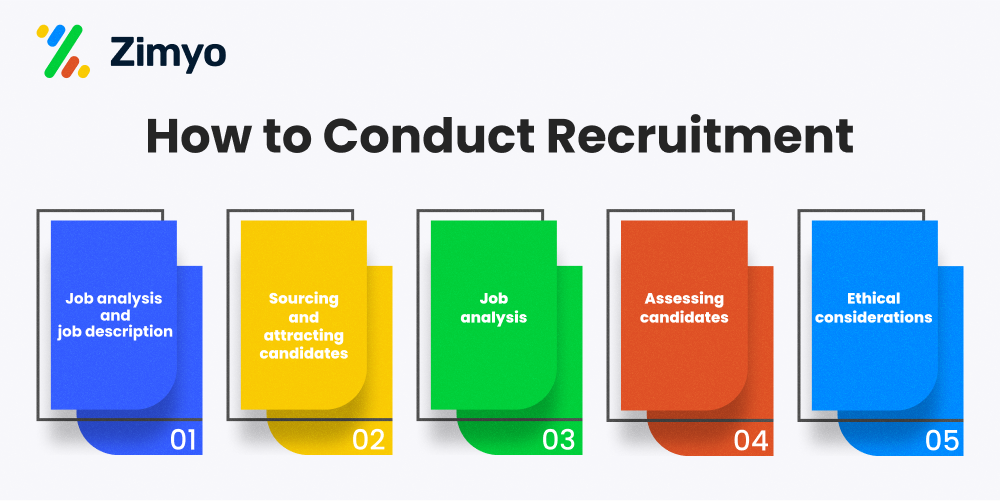
Now that we have covered how to create a successful recruitment strategy and the different methods of recruitment, we will now cover important topics to ensure that the recruitment process is efficient, effective, and compliant with legal and ethical standards.
Job analysis and job descriptions are critical tools in human resource management. They provide organizations with a framework to hire, evaluate, and manage their employees. This guide will guide you through conducting a job analysis and writing an effective job description.
A job analysis is defined as a systematic process of gathering and analyzing information about a job. A job analysis aims to identify the critical tasks, responsibilities, skills, and knowledge required for the job. Conducting a job analysis involves the following steps:
Step 1: Review existing job descriptions or performance appraisals for the job in question.
Step 2: Collect information about the job by observing employees performing it, interviewing the job holder, and talking to their supervisors or colleagues.
Step 3: Identify the critical tasks and responsibilities associated with the job.
Step 4: Determine the knowledge, skills, and abilities required for the job.
Step 5: Identify any physical demands, working conditions, or environmental factors that may impact job performance.
Step 6: Consider any relevant laws or regulations affecting the job.
A job description is a written document that outlines the essential duties, responsibilities, qualifications, and experience required for a particular job. An effective job description should be clear, concise, and accurately reflect the job analysis. Writing a job description involves the following steps:
Step 1: Begin with a job title that accurately reflects the position.
Step 2: Provide a basic of the position, including the primary purpose, fundamental duties, and reporting relationships.
Step 3: List the essential job duties and responsibilities in order of importance.
Step 4: Identify the minimum qualifications and experience required for the job, such as education, certification, and work experience.
Step 5: Specify any physical or environmental requirements, such as the ability to lift heavy objects or work outdoors.
Step 6: Identify any special skills or abilities required for the job, such as proficiency with specific software or equipment.
Step 7: Include relevant information, such as working hours, travel requirements, and salary range.
Reviewing and updating job descriptions on a regular basis is essential to ensure they accurately reflect the job and meet the organization’s needs. Job descriptions should be reviewed and renewed whenever market conditions change and if you feel that the position requires additional skills and requirements.
Job analysis and job descriptions are critical components of human resource management. Conducting a job analysis and writing an effective job description can help organizations attract and retain qualified employees and ensure that the organization has the right people with the right skills to achieve its goals.
Sourcing and attracting candidates is a critical component of human resource management. A company’s ability to attract the best talent can be the difference between success and failure. In this section, we will guide you through the process of sourcing and attracting candidates to ensure your organization has the right people with the right skills to achieve its goals.
Sourcing candidates involves the process of identifying and reaching out to potential job candidates. It can be challenging to find qualified candidates, especially for niche or high-level positions. However, there are several effective ways to source candidates, including:
Step 1: Leverage your network: Reach out to your professional network, employees, and colleagues to see if they know anyone who might be a good fit for the role.
Step 2: Use job boards: Post the job on job boards like Indeed, Glassdoor, or LinkedIn to attract a large pool of candidates.
Step 3: Attend job fairs: Attend job fairs or industry events to meet potential candidates face-to-face.
Step 4: Use social media: Promote the job on social media platforms like Twitter, Facebook, and LinkedIn to reach a broader audience.
Attracting candidates is about convincing qualified candidates to apply for the job. A compelling job description is the first step in attracting candidates. However, there are other ways to make your company more attractive to potential candidates, including:
Step 1: Offer competitive compensation: Ensure that your salary and benefits package is competitive in your industry to attract top talent.
Step 2: Provide professional development opportunities: Offer opportunities for professional growth and development to attract candidates who are looking to advance their careers.
Step 3: Create a positive work environment: Create a culture that values work-life balance, team collaboration, and employee well-being to attract candidates who are looking for a positive work environment.
Step 4: Highlight your company’s mission and values: Emphasize your company’s mission and values to attract candidates who share your organization’s vision.
It’s essential to review and refine your recruiting strategy regularly to ensure you are attracting the best candidates. Review your recruitment metrics, such as time-to-hire and applicant quality, to identify areas for improvement. Refine your recruitment strategy by experimenting with new sourcing methods, improving your job descriptions, and offering more competitive compensation and benefits.
Sourcing and attracting candidates are critical components of human resource management. By leveraging your network, using job boards, attending job fairs, and promoting the job on social media, you can identify a broad pool of qualified candidates. By offering competitive compensation, providing professional development opportunities, creating a positive work environment, and highlighting your company’s mission and values, you can attract the best talent. By reviewing and refining your recruiting strategy regularly, you can continuously improve your ability to source and attract top candidates.
By evaluating the candidate’s qualifications, fit, and potential, you can make the right hiring decision. By following these steps, you can ensure that you hire the best candidate for the role.
Assessing candidates involves evaluating their skills, experience, and qualifications to determine their suitability for the role. There are several effective ways to evaluate candidates, including:
Step 1: Use pre-employment tests: Use pre-employment tests to evaluate candidates’ skills, knowledge, and abilities.
Step 2: Conduct reference checks: Conduct reference checks to verify candidates’ work history and performance.
Step 3: Review work samples: Review work samples to evaluate the candidate’s ability to perform the duties of the role.
Step 4: Consider the candidate’s potential: Consider the candidate’s potential for growth and development within the organization.
Making the hiring decision involves evaluating the candidate’s qualifications and selecting the best candidate for the role. There are several effective ways to make the hiring decision, including:
Step 1: Evaluate the candidate’s qualifications: Evaluate the candidate’s skills, experience, and capabilities in light of the requirements for the role.
Step 2: Consider the candidate’s fit: Consider the candidate’s fit with the organization’s culture and team dynamics.
Step 3: Evaluate the candidate’s potential: Consider the candidate’s potential for growth and development within the organization.
Step 4: Make the offer: Make a job offer to the candidate who is the best fit for the role.
Interviewing and assessment are critical components of the hiring process. By preparing questions, using behavioral interviewing techniques, evaluating the candidate’s fit, and assessing their skills and qualifications, you can conduct compelling interviews. By using pre-employment tests, conducting reference checks, reviewing work samples, and considering the candidate’s potential, you can assess candidates effectively. By evaluating the candidate’s qualifications, fit, and potential, you can make the right hiring decision. By following these steps, you can ensure that you hire the best candidate for the role.
Diversity and inclusion are essential components of building a successful organization. It involves creating a workplace culture that values and respects differences and allows everyone to feel valued and included. In this eBook, we will guide you through the process of creating a diverse and inclusive workplace to foster creativity, innovation, and success.
Understanding diversity and inclusion is the first step in building a workplace culture that values and respects differences. There are several essential components of understanding diversity and inclusion, including:
Step 1: Recognize the benefits of diversity: Recognize the benefits of diversity, such as improved creativity, innovation, and problem-solving.
Step 2: Define diversity: Define diversity to understand the different ways in which people can be diverse, such as race, ethnicity, gender, age, sexual orientation, and religion.
Step 3: Define inclusion: Define inclusion to understand how to create a workplace culture that values and respects differences.
Creating a culture of inclusion involves creating a workplace culture that values and respects differences. There are several effective ways to develop a culture of inclusion, including:
Step 1: Set the tone from the top: Set the tone from the top by establishing leadership behaviors that promote diversity and inclusion.
Step 2: Encourage open communication: Encourage open communication to create a safe and inclusive workplace environment.
Step 3: Create opportunities for growth: Create opportunities for growth by promoting career development, mentoring, and sponsorship.
Step 4: Celebrate diversity: Celebrate diversity by recognizing and acknowledging the differences that exist within the organization.
Recruiting for diversity involves creating a diverse candidate pool and selecting the best candidate for the role. There are several effective ways to recruit for variety, including:
Step 1: Create a diverse candidate pool: Create a diverse candidate pool by using various recruitment channels and actively seeking out candidates from diverse backgrounds.
Step 2: Avoid bias in job descriptions: Avoid bias in job descriptions by using inclusive language and avoiding gendered or biased language.
Step 3: Use diverse interview panels: Use various interview panels to ensure a fair and inclusive hiring process.
Step 4: Evaluate candidates fairly: Evaluate candidates fairly by focusing on their skills, experience, and qualifications and avoiding bias.
Maintaining a diverse and inclusive workplace involves ongoing efforts to promote and reinforce a culture of inclusion. There are several effective ways to maintain a diverse and inclusive workplace, including:
Step 1: Provide ongoing education: Provide ongoing education to employees to promote awareness and understanding of diversity and inclusion.
Step 2: Collect and analyze data: Collect and analyze data to track the organization’s progress in promoting diversity and inclusion.
Step 3: Address and resolve conflicts: Address and resolve disputes that arise to ensure a safe and inclusive workplace environment.
Step 4: Recognize and celebrate successes: Recognize and celebrate successes in promoting diversity and inclusion to reinforce a culture of inclusion.
Diversity and inclusion are essential components of building a successful organization. By understanding diversity and inclusion, creating a culture of inclusion, recruiting for diversity, and maintaining a diverse and inclusive workplace, you can foster creativity, innovation, and success. By following these steps, you can create a workplace culture that values and respects differences, celebrates diversity, and promotes inclusivity.
Recruitment is an essential function of human resources (HR) management, and ethical considerations are vital in the recruitment process. It ensures that the organization’s recruitment policies, practices, and decisions align with moral and ethical standards. In this recruitment guide, we will guide you through understanding ethical considerations in recruitment.
To ensure ethical considerations in recruitment, organizations must follow several ethical principles, including:
Step 1: Fairness: Ensure fairness in all recruitment policies and practices, such as job postings, candidate selection, and hiring decisions.
Step 2: Respect: Respect the dignity and rights of all job candidates and stakeholders.
Step 3: Honesty: Be honest and transparent in all recruitment practices and communication with job candidates.
Step 4: Responsibility: Take responsibility for the organization’s impact on society and the environment and minimize adverse effects.
HR professionals face many ethical issues in the recruitment process, including:
Step 1: Discrimination: Avoid discrimination based on age, gender, race, religion, sexual orientation, or other protected characteristics.
Step 2: Candidate experience: Ensure a positive candidate experience by providing precise and accurate job descriptions, timely communication, and respectful treatment.
Step 3: Privacy: Respect candidate privacy by keeping their personal information confidential.
Step 4: Conflict of interest: Avoid conflicts of interest in recruitment decision-making, such as nepotism or favoritism.
To ensure ethical considerations in recruitment, organizations must use ethical decision-making processes, including:
Step 1: Identify the issue: Identify the ethical issue at hand, such as a conflict of interest or a violation of privacy.
Step 2: Gather information: Gather all relevant information about the issue, including policies, laws, and stakeholder perspectives.
Step 3: Evaluate all options: Evaluate all available options for addressing the ethical issue and determine the best course of action.
Step 4: Take action: Take action to address the ethical issue, such as implementing new policies, providing training, or corrective action.
Building a culture of ethics is critical for ensuring ethical considerations in recruitment. There are several ways to create a culture of ethics in recruitment, including:
Step 1: Lead by example: Leaders in the organization must model ethical behavior and hold themselves accountable for their actions.
Step 2: Communicate clearly: Communicate ethical expectations and values throughout the organization, and ensure recruiters and hiring managers understand them.
Step 3: Provide training: Provide training on ethical decision-making and practices to ensure all recruiters and hiring managers are aware of the organization’s ethical standards.
Step 4: Encourage reporting: Encourage employees and job candidates to report ethical violations and protect them from retaliation.
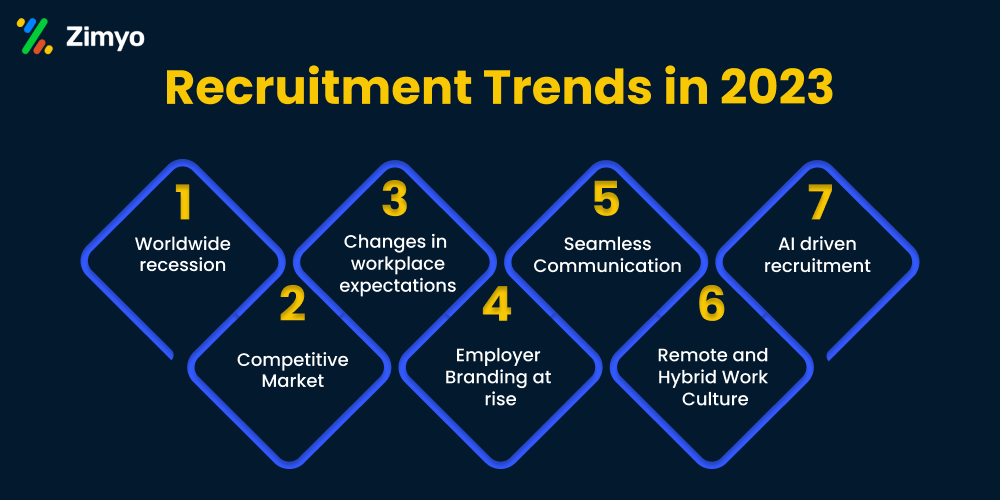
In 2023, recruiters should focus on a streamlined, data-centric approach to recruitment, employee retention through upskilling and talent pools, and a focus on diversity and inclusion.
Zimyo is a highly-rated recruitment software that streamlines every hiring process step, from finding suitable candidates to onboarding. It offers integrations with top job boards and provides features such as interview scheduling, automated email responses, and personalized notifications. Zimyo offers pricing plans starting at ₹6000 per month for up to two recruiters.
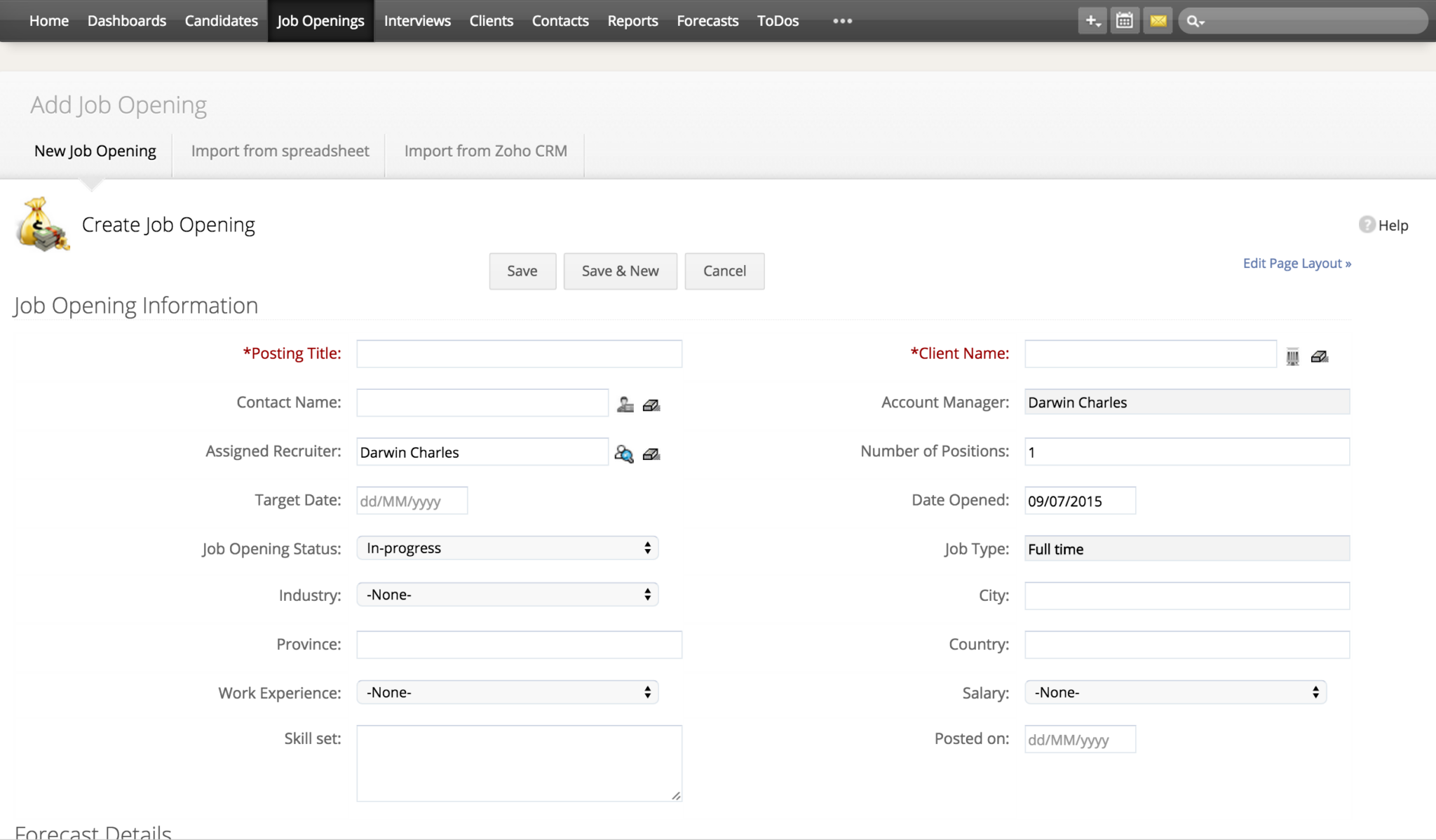
Zoho Recruit is an applicant tracking software that helps recruiters trace, monitor, and hire top-tier candidates. It provides features such as data-driven decisions, integrations with top job boards, and customizable reports. Zoho Recruit offers a free trial for 15 days, with pricing plans starting at $25 per recruiter per month.
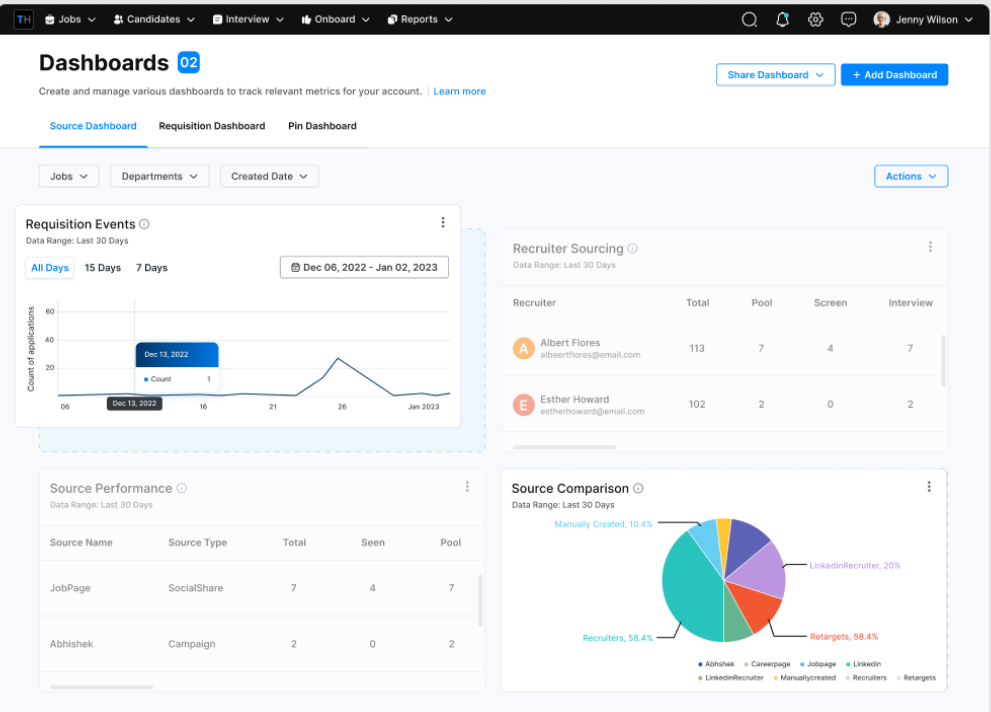
TurboHire is an AI-driven Talent Acquisition Platform that streamlines and manages hiring workflows with automated processes and machine learning. It provides features like one-click job marketing, innovative candidate brands for evaluation, and configurable workflow. TurboHire offers user licensing-based tiered pricing starting at $45 per user per month.
Recruitment is essential for any organization to thrive and succeed. The hiring process is the first step towards building a team to take the organization to new heights. A well-executed recruitment process can save time and money and lead to better hires that bring new skills and ideas to the team.
We have discussed various aspects of the recruitment process in this recruitment guide, from understanding the importance of recruitment to developing a recruitment strategy, conducting interviews, and selecting the best candidate. We have also explored different online and offline recruitment methods and their advantages and disadvantages.
We hope this recruitment guide has provided valuable insights and practical tips to improve your recruitment process. Whether you are an HR Head, a hiring manager, or someone responsible for recruitment, this guide will help you create a more effective and efficient recruitment process that leads to better hires and a stronger team.
Remember that recruitment is an ongoing process requiring continuous evaluation and improvement to stay effective. You can always leverage a HRMS services from platforms like Zimyo, which overlooks all your HR proceses from hiring to retiring. By following the strategies and tips outlined in this recruitment guide, you can create a recruitment process that attracts the right candidates, selects the best hires, and builds a team that is poised for success.
Also Read: